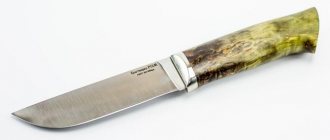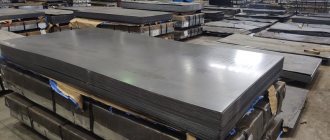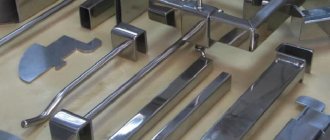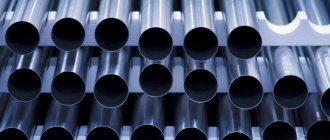The abbreviation HSS, made up of the initial letters of the English words High Speed Steel, denotes a whole group of steels classified as high-speed. Milling cutters, taps, and dies for thread cutting are made from steels of this type. Much less often, such material is used for the production of hacksaw blades and knives.
Alloys of the HSS category refer to high-carbon steels, some grades of which may contain significant amounts of tungsten. The hardness of a tool made from this type of steel can be in the range of 62–64 units on the HRC scale.
End mill made of HSS-Co8 steel is capable of processing material with a tensile strength of up to 1100N/mm2
Tools made from HSS steels, when compared with carbide steels, are more affordable and have higher strength, which allows them to be successfully used for interrupted cutting. Meanwhile, processing with their help is allowed at lower cutting speeds when compared with carbide drills.
The composition of high-speed steels, which foreign manufacturers call HSS alloys, has been constantly improved. So, from the end of the 19th century, a significant amount of tungsten began to be added to such steels (up to 18%), and from 1912 cobalt began to appear in these alloys. It was only in 1930 that molybdenum was included in HSS steels.
How do HSS drills differ from carbide models?
First of all, HSS drills differ from carbide drills in their material manufacturing technology.
- High-speed steel is produced by adding tungsten, chromium, molybdenum and other components to carbon steel. The material of HSS drills is highly durable.
- Carbide is a composite material made using powder metallurgy technology. It consists of micron-sized particles. The main component is tungsten carbide. Additional ones include titanium carbide, tantalum carbide, etc.
Carbide tools from HSS drills are characterized by higher hardness and heat resistance. However, hard alloys have lower strength. They are afraid of vibrations and force loads. This does not allow the use of carbide drills for intermittent machining of workpieces at high speeds.
Due to the complex manufacturing technology, carbide tools are expensive. Prices for drills made of high-speed steel are much lower.
Drill 19.5x198 mm c/x according to met. machined under Ø13 HSS-R RUKO art. 200195 RUR 1,445
Add to cart
Drill 22.0x205 mm c/x according to met. machined under Ø13 HSS-R RUKO art. 200220 RUR 2,270
Add to cart
Drill 24.0x205 mm c/x according to met. machined under Ø13 HSS-R RUKO art. 200240 RUR 2,903
Add to cart
Drill 25.0x205 mm c/x according to met. machined under Ø13 HSS-R RUKO art. 200250 RUR 3,102
Add to cart
Drill 19.0x198 mm c/x according to met. machined under Ø13 HSS-R RUKO art. 200190 RUR 1,326
Add to cart
Drill 20.0x205 mm c/x according to met. machined under Ø13 HSS-R RUKO art. 200200 RUB 1,535
Add to cart
Legend
The designation of foreign manufacturers does not fully disclose the chemical composition of the HSS steel from which the products are made. A particular tool is assigned a specific task, which is described in the catalog. Other details can be found out by determining the chemical composition, this can be done using a portable metal analyzer, or by testing the products experimentally. Such marking, of course, may be convenient for an unscrupulous manufacturer who may indicate HSS steel on the drill, but it will not meet the necessary requirements. Below are the main markings that characterize the material from which the tool is made and its scope of application.
HSS-R
(or simply HSS) is a designation on products that have undergone roller rolling and heat treatment. Such products have the lowest durability.
HSS-G
- designation on products that are made of HSS steels, the cutting part is ground with CBN (cubic boron nitride). The products have increased durability and less radial runout. HSS-G tools are the most common and are used to solve standard problems.
HSS-E
– cobalt is added to products made from HSS steel type M35. Used when working on viscous and complex materials. There are also such markings as HSS Co 5 and HSS Co 8, which indicate cobalt content of 5 and 8%
HSS-G TiN
– this marking indicates the deposition of titanium nitride. This coating allows increasing surface hardness by approximately 2300 HV and heat resistance up to 600°C.
HSS-G TiAlN
— surface of products coated with titanium-aluminum-nitride. This coating allows increasing surface hardness by approximately 3000 HV and heat resistance up to 900°C.
HSS-E VAP - VAP
-used for processing stainless steels (V2A and V4A). It is obtained by “evaporating” the oxide non-metallic layer. This reduces the adhesion of workpiece chips to the tool surface, which can lead to product failure. As a result, the surface quality is improved and, thanks to VAP, the adhesion of the coolant to the tool surface is improved.
| Characteristics of heat resistance of carbon and red resistance of high-speed tool steels | |||
| steel grade | Temperature, °C | Exposure time, hour | Hardness, HRC e |
| U7, U8, U10, U12 | 150—160 | 1 | 63 |
| P9 | 580 | 4 | |
| U7, U8, U10, U12 | 200—220 | 1 | 59 |
| R6M5, R6M5K5, R9, R9M4K8, R18 | 620—630 | 4 | |
Recommendations for selecting HSS drills
The following factors directly influence the choice of HSS drills.
- Grade of processed steel. The choice of tool based on the material of manufacture depends on it.
- Equipment that needs to be equipped with a drill. Buy drill bits with shanks that fit the equipment you have.
- Frequency of use. If you are looking for an HSS drill for one-time jobs, inexpensive models are suitable. If you use the tool often, do not skimp on quality.
You will find detailed information about choosing metal drills for various jobs in this article (put a link to the page with article No. 1).
Main characteristics and brands
Depending on their composition, HSS steels are divided into three categories:
- with a high content of tungsten (T);
- molybdenum (M);
- highly doped group.
Chemical composition of tungsten HSS steels
Due to the high cost and shortage of tungsten, steels with a high tungsten content are used quite rarely in our time. The most common steels in this group are the general purpose alloy T1 and the steel alloy T15 containing vanadium and cobalt. The latter is used, in particular, for the manufacture of products that must be highly resistant to wear and high temperatures.
Chemical composition of molybdenum HSS steels
More common are HSS molybdenum steels, which may also contain tungsten and cobalt. High-speed steels of the molybdenum group, which contain a significant amount of vanadium and carbon, are resistant to abrasive wear. For the manufacture of products that must maintain high hardness even at high temperatures, molybdenum steel alloys are used, starting from grade M41. In the production of tools operated in cold conditions and with high impact strength, steel alloys of the molybdenum group are also used, subjecting them to special heat treatment.
Chemical composition of high alloy HSS steels
When choosing tools from HSS steels of the molybdenum group, you should take into account the characteristics of individual grades of such steel alloys.
M1
HSS drills for a wide range of applications are made from steel of this grade. HSS drills made from M1 alloy are more flexible and less susceptible to shock loads, but their red-hardness level is lower than that of tools made from M2 steel.
M2
This is the most common material from which tools for various purposes are made. Products made from HSS steel of this grade, used for high-performance machine work, are distinguished by high red resistance; the parameters of their cutting edges are maintained longer than those of tools made from high-speed steels of other brands.
M7
This alloy is used to produce powerful drills, which require not only high flexibility, but also exceptional reliability. Using HSS metal drills, made from this alloy, holes are made in hard and thick sheet materials.
M50
This is the material used to make drills that work with portable equipment. Under these conditions, tool breakage due to significant bending is a fairly pressing problem. An HSS drill made from M50 steel alloy does not have the same red resistance as tools made from other grades of high-speed steel.
M35
This alloy, which is also designated as HSSE, due to the increased cobalt content, has higher red resistance than M2 high-speed steel. Meanwhile, the increased content of this element in the composition of HSSE steel reduces its resistance to impact loads.
M42
This is a steel that contains the maximum amount of cobalt, which is why it is often called Super Cobalt. Tools made from HSS steel of this grade are distinguished not only by their high red resistance, but also by their exceptional abrasion resistance. Thanks to these characteristics, steel of this grade is successfully used for the production of tools with which it is necessary to process viscous and complex materials.
The tungsten content in HSS steels allows the products made from them to be red-hardened.
This quality lies in the fact that the cutting edge of the tool retains its hardness even at a red heat temperature of 530°. High-speed steel alloys containing cobalt (HSS Co) have an even higher red-hardness (as well as increased wear resistance). The cutting edges of HSS Co grade drills are able to maintain their hardness at higher temperatures.
Drill extension
Extension products are an elongated rod that allows you to make deep holes in different materials. When choosing an extension, it is important to consider that its diameter should be less than the parameters of the drill.
Extension for Lewis drills STAYER 2952-10
Extension for Lewis drill . The product is suitable for spiral equipment. Externally, the design is similar to a thin cylinder. One end is shaped like a hexagon. The extension cord is used primarily for working on thick wood. The kit sometimes includes a special key. The material for the manufacture of this type of extension is carbon steel.
Extension for Forstner drill . The cylindrical shape of the rod is complemented by a hexagonal shank (length 10-12 mm). The other end of the product has a seal that ensures a strong connection with the equipment. The total length of the structure is 140 mm.
Models for feather drills . The design shape is the same as other extension cords. Features a round tip. The total length of the product is 140-150 mm. Use is not limited to making deep holes. Often the equipment is used for drilling in hard-to-reach places on the surface.
There are also flexible extensions for equipment. They are made of black plastic, which has a soft structure. The ends of the plastic product are equipped with metal tips, including a hex shank.
Marking of drills according to GOST
The marking of products for drilling is regulated by GOST 2034-80. This document stipulates that equipment whose diameter does not reach 2 mm is not applied to the drill. Information is indicated only on the packaging label.
Products with a diameter of 2-3 mm are marked on the shank indicating the diameter and steel grade. Encryption of equipment whose diameter exceeds 3 mm includes the following information:
The metal grade is indicated in the domestic GOST version (for example, R6M7K6), or international (HSS). Information about additives (Co, Ni, Ti, etc.) can also be supplemented.
International standard color coding
| Color | Group | Processed materials |
| Golden | S | Heat-resistant alloys with the addition of titanium, cobalt, iron, nickel. |
| Green | N | Duroplasts, thermoplastics. Non-ferrous metals, alloys made from them. |
| Grey | H | Hard grades of hardened steel. |
| Red | K | Different grades of cast iron. |
| Blue | P | Steel for castings, some types of corrosion-resistant steel, carbon steel, tool steel. Alloyed. |
| Yellow | M | Austenitic steel is corrosion-resistant, some types of non-magnetic steel are wear-resistant. |
Features of heat treatment
The result of high-temperature processing of high-speed steels is a change in the structure of the material to obtain certain physical and mechanical properties required when working with this tool.
Annealing
HSS steel after the rolling and forging process acquires increased hardness and internal stress. In this regard, the workpieces are preliminarily annealed. Annealing relieves the internal stress of the material, improves machinability and prepares it for hardening.
The annealing process occurs at a temperature of about 850-900°C. However, one should be wary of excessively increasing the temperature and duration of exposure, because this may cause the steel to become more hard. Due to the reduced thermal conductivity of the alloy, heating is carried out slowly and evenly.
The products are loaded into the oven at a temperature of 200-300oC, while subsequent heating is increased at a rate of 150-200o/hour. The process ends with slow cooling: first in an oven to 650 ° C, and then to room temperature in the open air.
To protect against decarburization, annealing is carried out in closed boxes with a neutral environment.
Machine-building plants subject a small number of workpieces to isothermal annealing. They are heated to 880-900oC for a short time, and then transferred to an oven with a temperature not higher than 720-730oC for 2-3 hours. To protect against the appearance of excessive internal stresses, the workpieces are cooled in an oven to 400-450°C and then left in the open air.
Conventional annealing takes longer than the isothermal process. Subsequently, the workpieces undergo mechanical processing, and then the tool undergoes the final heat treatment process - hardening and tempering.
Hardening
Tools made of high-speed steel are hardened at temperatures above 1300°C. After the hardening process, repeated tempering occurs at 550-560°C. This temperature is necessary to dissolve a large number of carbides in the austenite to obtain highly alloyed austenite.
With further cooling, highly alloyed martensite is obtained, which contains large amounts of tungsten, vanadium and chromium. Martensite does not disintegrate when heated to 600°C, which gives high-speed steel red-hardness.
To obtain high red-hardness values, the temperature during hardening must be very high. However, there is a limit, when exceeded, rapid grain growth begins in high-speed steel and melting occurs.
Vacation
Hardened high-speed steel must undergo a tempering process. At a temperature of 550-560°C, a multiple process is carried out at intervals of 1 hour. The purpose of tempering is to transform austenite into martensite. High speed steel goes through two internal processes:
- When heated and subsequently tempered, ground carbide is released from the retained austenite. As a result, the alloying of austenite is reduced, which facilitates easy transformation into martensite.
- During cooling at 100-200°C, martensite is obtained. This also relieves the internal stress that arose during hardening.
Nowadays, factories most often use the process of accelerated tempering of steel, which takes place at elevated temperatures.
Area of application of high-speed steels
The composition of the material determines the application and performance characteristics. Tools made from this metal can withstand long-term use.
HSS steel is used:
- for the production of drills with complex shapes and designs obtained by casting;
- in the production of cutting edges of cutters to increase wear resistance;
- for forming cutting tool tips;
- for the manufacture of cutters, countersinks, taps, dies, knives or saw blades.
What steel are metal drills made of and which is better?
To choose high-quality drills that can last a long time and maintain sharpness despite repeated use, it is important to know what types of steel such a tool is made from and what their differences are. The best metal drills are made from high-speed steel HSS (a common abbreviation) with the addition of a number of impurities
The price of the instrument and the properties described above depend on their type and quantity.
High speed steel is characterized by its high hardness, ability to resist fracture and tolerance of temperature resulting from drilling speed. The material is doped with special impurities, which is indicated in the marking.
For example:
- P - reports that tungsten is present in the alloy.
- F is an indicator of the presence of vanadium.
- M - indicates the addition of molybdenum.
Sometimes manufacturers list the type of steel as a special benefit of their products. What can such a marking tell us? Let's look at popular options.
Drill bits made of HSS-E steel
5-8% cobalt is added to this high-speed steel. This technological solution allows them to drill into stainless steel with a tensile strength of up to 1200 N/mm2. Designed for particularly astringent and difficult materials when heated. Instead of the letter E, they may be designated Co.
HSS-E steel drill
Drills made of steel HSS-TiAIN
They have a three-layer coating (titanium-aluminum-nitride). This increases their heat resistance to a temperature of 900 degrees and allows them to be used on steel with a strength of 1100 N/mm2. They have an increased service life, 5 times longer than other types.
Drill made of HSS-TiAIN steel.
Drills made of HSS-TiN steel
The marking indicates that the outer layer is sprayed with titanium nitride. This adds strength and increases heat resistance up to 600 degrees. Suitable for making holes in cast iron, aluminium, carbon and alloy steel with a tensile strength of 1100 N/mm2.
Drill made of HSS-TiN steel.
Drill bits made of HSS-G steel
Suitable for cast iron and various types of steel with a tensile strength of 900 N/mm2. The cutting part in them is polished using cubic boron nitride. This gives resistance to radial runout and abrasion resistance. Drills made of this steel are the most common.
Drill made of HSS-G steel.
Steel drill bits HSS-R
This is a high-speed steel with the lowest durability. It can also be indicated simply without the letter R, which will mean conventional heat treatment (hardening) and roller rolling. Suitable for creating holes in mild steel and cast iron.
Drill made of HSS-R steel.
Carbide drills
This type of material only touches the tip of the drill. It is designed to withstand very high temperature loads and is abrasion resistant. This HHS is used for drills designed to work with titanium alloys, heat-resistant steels and stainless steel.
Carbide drills.
Characteristics of high-speed steels
When listing the characteristics, it is necessary to take into account that the created material is necessary for the operation of cutting devices at high levels of friction that arise during the cutting process. High-speed steels have increased hardness and can be used in work requiring high speeds.
Hot hardness
When using cutting devices during operation, heat is constantly released, and about 80% is spent on heating the tool. The temperature of the cutting edge rises and the material is tempered, which entails a decrease in its hardness. Nevertheless, high-speed steel retains its performance even when heated to 500-600°C.
Red fastness
An indicator that takes into account the time period during which steel can withstand elevated temperatures without changing its performance characteristics. An overestimated friction index leads to heating of the metal, which causes changes in the crystal lattice. As a result, some properties of high-speed steel change significantly.
Fracture Resistance
The material used for the manufacture of cutting tools must have high mechanical properties - resistance to brittle fracture. The high strength of the alloy provides the cutting device with resistance to high force, feed and depth of cut, which in turn leads to increased productivity of the process.
What is HSS steel
The abbreviation HSS is derived from the English High Speed Steel - “high-speed steel”. It is used in the production of various tools for working with metal products. For production, the classical method of casting into ingots followed by rolling and forging is used. The powder method is also used - spraying a stream of liquid steel with nitrogen.
HSS alloys belong to the high carbon group, some grades of which contain a certain amount of tungsten. The hardness of tools made from this material corresponds to 62-64 units on the HRC scale.
Products made from high-speed steel have increased strength and are in an affordable price segment.
Classification by size
To choose the best drill and not overpay, it is enough to know what length sizes these products are usually divided into. If drilling metal does not require making deep holes, then purchasing models that are too long will lead to cost overruns.
It is customary to classify drills by length as follows:
- Short, 20-131 mm long. Tool diameters are in the range of 0.3-20 mm.
- Elongated, length is 19-205 mm, and diameter is 0.3-20 mm.
- Long series with a diameter of 1-20 mm and a length of 56-254 mm.
When performing drilling work of various depths, you should select the tool that is most suitable for the specific task.
HSS-R, HSS-G, HSS-Co, HSS-E — trunk_2007
Regarding the Queen of the Fields Р18GradeCCrMoWVCoР18T1
| 0,73-0,83 | 3,8-4,4 | <1,0 | 17,0-18,5 | 1,0-1,4 | <0,50 |
| 0.65–0.80 | 3.75–4.00 | — | 17.25–18.75 | 0.9–1.3 | — |
In the 70s of the 20th century, due to a shortage of tungsten, high-speed steel grade R18 was almost universally replaced by steel grade R6M5, which in turn was replaced by tungsten-free steel R0M5F1 and R0M2F3.
The designation HSS stands for “High Speed Steel” and generally applies to the entire class of high speed steels. However, in most cases this is the designation for the most widespread steel of this class - P6M5 (M-2; 1.3343; Z85WDCV; HS 6-5-2; F-5613)
| 0,82-0,90 | 3,8-4,4 | 4,8-5,3 | 5,5-6,5 | 1,7-2,1 | <0,50 |
| 0.95 | 4.2 | 5.0 | 6.0 | 2.0 |
GradeCCrMoWVCoР6М5M2
Approximate translation of European names of steels to our GOSTs: HSS - High Speed Steel - high-speed tool steel, analogue of P6M5 (1.3343 - S6-5-2 DIN). HSS-R - rolled tool.
HSS-G - tool steel, analogue of P6M5. G (Grinding) - polished tool.
HSSE, HSS-E, HSS-Co version of HSS-G alloyed with cobalt is usually M35 - tool high-speed steel, analogue of R6M5K5. CHSS-Co8 - tool high-speed steel, analogue of R6M5K8 - M42.
“M42 is a molybdenum series high speed steel alloy wit,h an additional 8% cobalt. It is widely used in metal manufacturing because of its superior red-hardness as compared to more conventional high speed steels, allowing for shorter cycle times in production environments due to higher cutting speeds or from the increase in time between tool changes. M42 is also less prone to chipping when used for interrupted cuts and cost less when compared to the same tool made of carbide. Tools made from cobalt-bearing high speed steels can often be identified by the letters HSS-Co. "
CV - chrome vanadium tool steel.
About HSS-R, Google gives an adequate link exactly 1 - to the section on high-speed steels in the German Wiki. Holy shit.
Improving the characteristics of products made from HSS steels
To impart hardness to the material, resistance to wear and resistance to corrosion, the surface of the tools is subjected to additional processing. These methods include:
- Nitriding. Saturation of the surface layer with nitrogen is carried out in a gas environment, which consists of 80% nitrogen and 20% ammonia or 100% ammonia. The technological process lasts from 10 to 40 minutes at a temperature of 500-600°C and leads to strengthening of the surface shell.
- Cyanidation. Saturation is carried out in a liquid or gaseous medium consisting of a chemical element - zinc. The high-temperature cyanidation process lasts from 5 to 45 minutes at a temperature of 800-900oC. The low-temperature process occurs at 500-600°C and provides wear resistance and high hardness to the tool.
- Sulfidation. Saturation of the surfaces of steel products with sulfur is carried out at 550-600°C by heating in sulfur-nitrogen salts for 2-3 hours. As a result of the process, the wear resistance of steel products increases.
The essence of chemical-thermal treatment is the penetration of various chemical elements into the atomic crystal lattice of iron when heating steel parts in an environment saturated with the necessary elements.
High-speed alloy steels are intended for the production of metal-cutting tools, which are used when working at high speeds. HSS alloys are distinguished by their ability to maintain wear resistance and resistance to fracture at elevated temperatures. The addition of molybdenum, tungsten, cobalt and vanadium to the steel composition provides red resistance and hot hardness.








